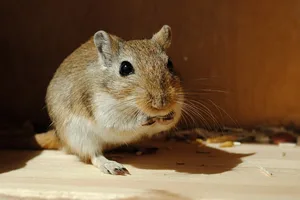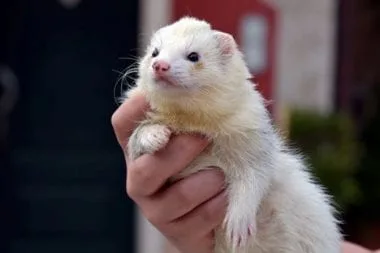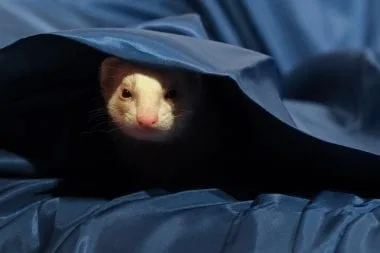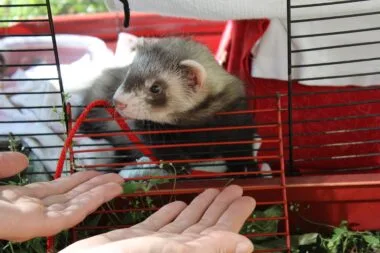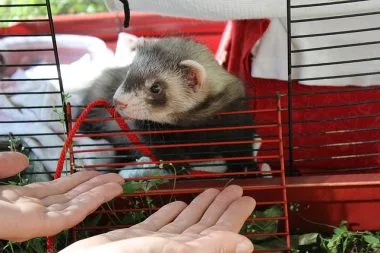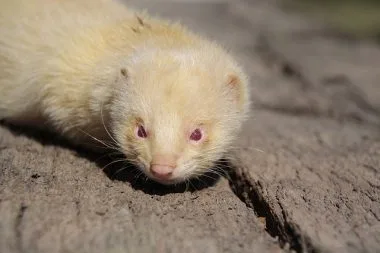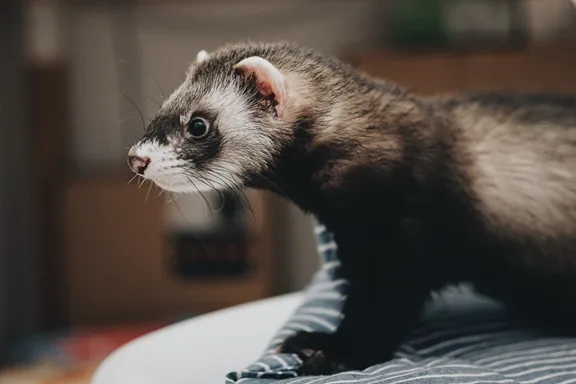
Ferrets are small mammals that come from the family of Mustelids. The male Ferret is called a Hob, the female is called a Jill, and the young ones are Kit. These tiny and cute animals are usually not associated with being house pets, however, there are people who do own and care for ferrets. Caring for ferrets, especially pregnant ferrets can be a Herculean task, but the rewards are numerous.
Before pregnancy
Jills usually attain sexual in about 4-8 months and the estrus (periodic sexual cycle of female mammals) interestingly is stimulated by photoperiods that can range from 14 to 16 hours. This means that ferrets are dependent on the intensity of the light source and the duration of the photoperiods. If estrus is prolonged, the jill may run into unnecessary health issues that could be fatal. It is advisable to breed after approximately 2 weeks once the initial signs of estrus have begun.
The mating ritual between the hob and jill is a long and arduous process. The hob bites the neck of the jill which stimulates hormones and triggers ovulation. Ferret owners must prepare, as this may go on for at least for a few hours and can last up to a few days.
During pregnancy
After the jill and hob have successfully mated, a pregnant ferret will have started to gain weight. She might also start to pull her fur out from her tail and body, to make the bedding comfortable. Another sign of pregnancy is that she will make a clucking sound. A pregnant ferret will also experience abdominal palpitations, which can be seen around 12-13 days after day 0 of breeding. However, if you are unsure, you can get an ultrasound done. Sometimes, female ferrets bloat due to high hormone levels. This is known as phantom pregnancies.
- Food
A pregnant ferret has to eat more, to compensate for the immense energy that she will expel. She will need a high-quality diet with a minimum of 20% fat content as well as 35-40% of good quality meat-based protein. Adequate water must be provided as she will drink almost 2-3 times her regular consumption. Some ferret parents also supplement the diet with dry food that is soft with warm water. This can but not necessarily provide a well-balanced and high protein diet.
The diet must be carefully administered for any changes in the diet could be detrimental to the jill and her kits. Pregnancy toxemia, stillborn kits, emergency cesarean, etc. can happen at any time, so it is very important to pay careful attention to her diet.
- Nesting and temperature.
It is important to keep the pregnant ferret as comfortable as possible. A nest created for the jill, preferably with shredded aspen shavings, or shredded paper. The nest must also be 6 inches (ca. 15 centimeters) deep so that the kits do not wander once they are born. It should be kept in a warm and quiet area of the house. The temperature is crucial to the pregnant ferret. The kits require a temperature of 18 to 21 degrees Celsius. Ferrets cannot survive in temperatures above 30 degrees Celsius, due to their sweat glands being poorly developed. They are vulnerable to heat prostration.
- Sound and light
There must be minimum noise and disturbance a week prior to the parturition. Unfamiliar sounds, loud noises, sudden disturbances can cause undue stress to the pregnant ferret and may cause severe complications. This lack of noise must last until a week after the kit arrives, as it may cause the jill to eat her own young. During pregnancy, parturition, and right up to lactation, a 16-hour photoperiod is vital. If this is ignored, there can once again be dire repercussions like pregnancy toxemia and a negative energy balance.
Once the birthing process has begun, the jill must be kept in a quiet, and secluded part of the house with adequate water. Any disturbance would result in cannibalism and stress issues with the jill. It is key to only intervene if there is an emergency, such as the kit tangled in the umbilical cords, the jill becoming dehydrated as a result of this complication. Even a prolonged birth would be harmful to the kit already born. They must be kept warm until the jill has delivered the other kits and then return it to the female ferret.
After pregnancy
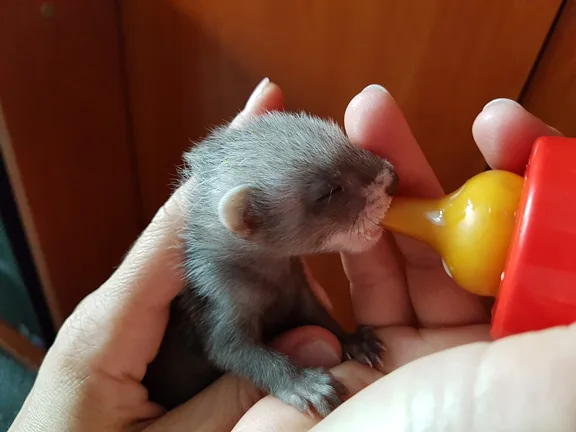
Once born, as mentioned, leave the kit and jill alone for at least a week. If she feels threatened or scared, she will eat her offspring. She will need to eat regular food. Do this as sneakily and carefully as you can. The jill is now lactating and will require the same amount of food as in the final stages of pregnancy, to compensate for her increased energy expulsion. A large litter means that she will lose weight, it does not matter how much you feed the jill. Food and water must be available at all times, and her bedding changed only when necessary.
There must be ample ventilation to air out the foul stench that can arouse from the bedding but do not change the bedding unless to check the progress of the kits. It is also important to keep an eye out for mastitis (Inflammation of the mammary gland). The gland may look swollen, blue and will hurt the jill. If any of these situations arise, contact your vet immediately.
The kits are born deaf and blind. Their eyes and ears will remain closed for the first 2 weeks, and they should be about 2 inches (ca. 5 cm) in length. Only handle the kits after a week, if the jill is not comfortable with you and her kits, try again another time. Do not push this, as you don’t want her to eat them. If she has expressed some level of comfort, pick up the kits and let them sit in your palm. Once they are older, pick them up by very softly grasping them between the shoulder and neck, much like handling a kitten. Support their hind legs with your other hand. Do not hold them for too long, a few seconds each time, and gradually increase it later.
Weaning the kits
After 3 weeks, the kits can start being weaned off the jill. The longer they feed, the more energy she loses and the weaker she will get. They can start eating solid ferret food around this time, but due to their baby teeth, soaking the food would ideal. Gradually decrease the soaking while simultaneously increasing the solid food. The food should be high in protein and fat but low in carbohydrates. By week 6, their adult teeth would have grown, and they should be completely weaned. They can hurt the jill with their teeth if not weaned by this time. But do not separate them until 12 weeks of age.
The kits must be vaccinated at 8-10 weeks old. Common vaccines such as booster vaccines, deworming, and even rabies can be administered, though some do not opt for the latter. They are also vaccinated for canine distemper at 8, 12, and 16 weeks.
Conclusion
Pregnant ferrets can be a handful. They are very temperamental and must only be handled if you have sufficient experience in handling animals. If you have no experience, getting a ferret might not be such a good idea. Breeding and taking care of pregnant ferrets involves diverting a lot of time and money to the ferret and her litter. If they are done properly, they can be very happy, living a long and happy life, with lots of babies. Make sure to watch out for the photoperiods, temperature, as well as noise, and disturbances.
After the jill litters, you can get her spayed, as this will stop her from going through estrus again and ensuring a longer life span. Ferrets are considered geriatric after 3-4 years, it is wise to spay her while you can. If estrus arises once the kits are born, hormones can be administered to prevent it. Even breeding with neutered males can help the jill during estrus.
There are many breeds to choose from when it comes to ferrets, however, they will prove to be fantastic pets and great companions. The kits are playful, lively, and energetic. They can be great stress busters and very therapeutic. Ferrets are delicate creatures and must receive the proper care. Please adopt only if you can provide a loving and nurturing home for these animals.

